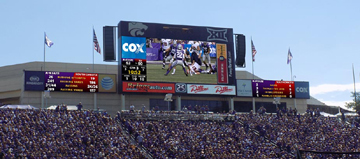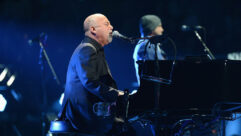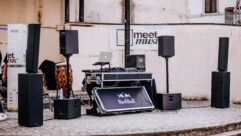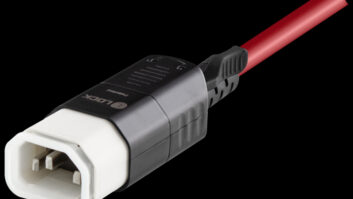
SVC Podcast – Show Notes – Show 180-1
In this edition of the SVC Podcast, Contributing Editor Bennett Liles talks with John Olsen from Daktronics Audio Sales about the very recent video and sound upgrades to Bill Snyder Family Stadium at Kansas State University. John outlines the sound side of the project which involved amps, speakers, Yamaha digital sound mixers and a new Shure wireless microphone system. He also comments on the challenges of keeping the project on time and within budget.
Links of interest:
- Daktronics – Sound Systems
- Yamaha QL1 and QL5 mixers used at the stadium
- Shure Wireless Microphone Systems
- QSC Q-SYS Sound Control and Monitoring
Download Podcast Here:
https://s3.amazonaws.com/nb-svc/public/public/180-1_Daktronics_Kansas_St…
This is the SVC Podcast from Sound & Video Contractor Magazine with John Olsen of Daktronics. Show notes and equipment links for the podcast are on the web site of Sound & Video Contractor Magazine at svconline.com.
Kansas State University has spent millions for an ongoing renovation project at Bill Snyder Family Stadium in Manhattan, Kansas and they brought in Daktronics to put in big new video displays and an a brand new sound system that works with the stadium’s new acoustics. John Olsen of Daktronics audio sales is with us today to give us the story on the sound part of the project. We’re ready to go on the SVC Podcast.
John it’s going to be very interesting having you with us today from Daktronics audio sales for the SVC Podcast. It seems to me that when most people hear about Daktronics they think of huge video displays and scoreboards in sports stadiums but Daktronics also has a very substantial sound system engineering operation.
Yeah, that would be correct, Bennett. We do. I guess you have, from the standpoint of some of our history – I’m not sure what you’re familiar with there, what the listeners are familiar with. Obviously Daktronics has been in business for well over 40 years, going on 45 years here – almost 50 now. About 12 years ago, Daktronics acquired a company that they had been working with for quite some time. It was a company called Dodge Electronics and they were based out of Topeka, Kansas and Dean Dodge was the owner of that business. After doing so much business with Dodge Electronics, Daktronics just decided that it would probably be a good idea to just bring that whole entire company into and under the umbrella of Daktronics, which is what happened. And then shortly after that occurred, I came on the picture here, too. And actually the company still has some of its original employees working for us today. Dean Dodge is the national sales manager for audio systems, so he is my direct supervisor. [Timestamp: 1:32]
All right. And I think you’ve had something like 150 large audio installation projects just in the past year or so.
We have a couple of different types of projects that we do and they’re based on the products that we offer. For instance, the 150-160 that we put in in the last fiscal year, those just account for what we call standard systems that we manufacture here in our plant in South Dakota and are purchased for basically a pre-engineered solution that allows the customer to have a stadium sound system for a very reasonable cost not only for the product but for the installation, and we have three different versions of that particular line that we sell. And then on top of that, the 160 or so installations that we did last year just on the standard product side, we’ve done quite a bit more in terms of our custom installations, which includes obviously stadiums and arenas as our mainstay, but then we also have a commercial video division where we provide some sound systems to various malls across the country. [Timestamp: 2:38]
Daktronics just finished a very big technical renovation project both for sound and video at Kansas State University’s fifty thousand seat stadium and I think it’s referred to as the Bill Snyder Family Stadium.
That would be correct, yes. We just completed that installation about a month ago and that was a retrofit into an existing scoreboard. It required quite a bit of modification to some structural components where we had to actually add onto the scoreboard. Fortunately enough for us, and I think for K State, we had done the original structural for the scoreboard that we were coming off of there. And that helped us out a lot and kept the project on time and on schedule and within budget. [Timestamp: 3:18]
This renovation project has been a marathon for Kansas State. It’s been going on for years and I think they’ve put something like 195 million dollars into it. I would think it’s good that they got all of the structural parts of the stadium done before the sound system instead of the other way around.
Yeah, it kind of helps to know what we’re going into and what the coverage of the speaker systems need to be. And in their case we went from mostly what was a point-and-shoot system to two very large line arrays by JBL. And then some additional coaxial boxes, which are two-way boxes that cover some of the near field seating. But the VLA line arrays that we installed there really do cover the stadium very nicely. [Timestamp: 4:05]
When you got in there and listened to the stadium’s existing sound system how did you decide on the design for the new one?
Just to kind of dial back the history on that, we actually put that original system in about 10 years ago and it had just pretty much run its course in terms of age. And the stadium was in a different state at that point in time, so it pretty much just worse itself out. The university wore it out over the course of time. But in terms of the new design what we do is we have an engineering team here internally at Daktronics where they will take the stadium X, Y and Z axis. We create a three-dimensional model and we use a program called EASE, which is a electro-acoustic software for engineers. And that program allows us to actually build the stadium, put the services of the stadium in, put the various structures of the stadium in, and then design a speaker system around those things. Now not withstanding, once that’s completed we also have to consider how are we going to integrate the system into structures. In this case we had to actually cut through the siding on an existing structure and attach some main beams within that. There was numerous types of approvals that had to be done with the engineer of record to verify that the structure would support what we wanted to do there. And then we have to obviously take out all the other equipment and electrical systems and then put the new equipment in. So it was a very extensive process, but with the teams that we have internally not only from the acoustical design standpoint, but also electrical engineering standpoint, structural engineering standpoint, and mechanical engineering we have a very experienced team that’s able to put these systems in place because oftentimes they do take a lot of validation and certification of what we’re going to do. So in this case, that was one of the things that we had to deal with. [Timestamp: 6:03]
Once you had the results of the EASE analysis and you had the design laid out what did you decide on for the amps, speakers and other hardware that was going to go in?
The amplification of the system, because they had already had a QSC Q-SYS digital signal processing system in there for digital audio transport, we are certified in those systems so we just decided that it would be best to utilize QSC amplification. And that obviously gives everybody a common reference and framework for any kind of service or maintenance things that have to happen. On top of that then the speaker models that we used in this case are JBL VLA’s which are totally weatherized – essentially weatherproof – and will give the university quite a few years in the position that they put in. It’s a big leap. The other part of it, too, is that with the amplification that we use we really try to keep the amplifiers as close to the speakers as we possibly can get them. And in this case we built several NEMA, or weatherized enclosures, with air conditioning to keep the equipment not only cool, but control humidity and just to provide solid performance through the course of the system’s lifetime. And then on top of that what we do with all of our customers of this magnitude is we build control panel systems and control monitoring systems that are just specific to their system so they can utilize the system, set the system up like they would like to and make adjustments in the system. We have presets in there and they can actually view into the system to find out if there are issues with amplifiers or speakers or anything like that. So if there are any kind of failures or parts that are for instance going out of range, then there are warnings that are flashed up and the customer can take care of those or call us and we will take care of them. That’s all part of the control panel monitoring systems that we built. We have our own template that our system design engineers have programmed and we plug obviously all the parameters of the amplifiers and setup of the amplifiers into that system. And it communicates digitally from the amplifier back into the digital signal processing system. And bring it up on the monitor in the control room and basically look at how all the amps are functioning in real time. So if there’s going to be a problem with the system, you can usually spot those. And there’s also warnings that will be – that will prompt the user that there’s a part that’s out of range. And that’s typically by color or whatnot. [Timestamp: 8:38]
And you also added a wireless microphone system to this?
Yes, we did. One of the problems that most venues have today, especially in the NCAA and other pro stadiums, is the incurrence of just all kinds of RF. So the way that the stadium performs when it’s empty – when wireless microphones are typically tested – they usually don’t have a whole lot of interference so you can validate that yeah, your ref mic is working correctly. But on a game day you’ll load the entire stadium with 50-60-70-80,000 fans and you know what all those fans have. They all have cell phones and they’re all competing within the confines of that stadium for their little slice of that bandwidth, that RF. And some of that RF and those signals end up in some cases interfering with the wireless mics. But there are also TV trucks that come in. We have TV Band devices that are activated by the networks that will cause interference and sometimes the network people just find an open channel and use it without any consideration for what else might be going on in the stadium or with the systems. Now what that’s done to the ref mic situation is that it’s made it very difficult for the ref mic to operate without any dropouts. There are many places, and K State was one of those, that they were having issues on game days with their referee mic. And so what we did there is we installed a new referee microphone system by a company called Shure and that equipment dynamically changes the frequency on the transmitter as well as the receiver and also just sets up an entire list of channels that the wireless microphone can switch to if the one that they’re on has some sort of spurious incursion or it can’t be used any longer because somebody has keyed in and started to use that particular frequency. [Timestamp: 10:29]
Yeah, I’ll bet that as the fans start showing up for the games, if you have an RF spectrum analyzer you can watch the grass grow on the display as the RF environment intensifies.
Yeah, you do. Yeah, you do. And it’s real interesting. Even with the Shure product that we put in they have a little piece in there that gives you that spectrum analysis capability in the range where the microphone is operating. And I’ve been in many situations where we sat down with a customer and we’ve trained them on how to use this and you see all the frequencies. You might have a list of, let’s just say, 50 different frequencies that the microphone is capable of switching to and there’s not a whole lot of RF activity going on in the stadium at that time. But then when the crowds are that list just continues to shrink and shrink and shrink. So I’ve seen it shrink from 50-plus down to 15-20 frequencies that the microphone will switch to if it needs to. And then that whole spectrum, like you said, you see all the grass grow. [Timestamp: 11:22]
That’s really something to behold on a big live sports event with the huge crowd coming in. I think you also provided them with a digital mixer for this one?
Yeah, actually we supplied two digital mixers, both by Yamaha in their QL family. One is a QL1 model and the other one is a QL5. The QL1 model is used in the PA room for all the essentially game day audio control ability and then the QL5 is in their video production suite. So they do all of their own video production for a number of different things that they distribute out to. But they were using an older Yamaha mixer back in that suite and the newer Yamaha mixer is now of the same family and are very similar to what was then a Yamaha M7 which was the standard for a lot of colleges and universities at this level. So that helped them out in terms of us being able to establish a very robust digital audio network with new equipment, which obviously is important. Some people think well, it’s digital. It will never wear out. Well, it’s not always the case, but having the same common functionality and the same purview into either system, one system can back the other one up. For instance if there is a problem with the mixer in the PA room that functionality can be switched over in just a very short amount of time over to the production mixer in the video room. Obviously they wouldn’t have a view back down on the field, but everything that’s on that mixer can be moved over to the mixer in video production for control so in case there’s some sort of issue with that mixer. [Timestamp: 13:06]
Well, redundancy is great to have especially when you’ve got that many fans in the stadium ready for action. They’ll let you know if things don’t sound right, I’m sure.
Oh, yeah. They do. [Laughs]
So now you’ve got them equipped with a system that can take them into the future. You’ve got other things coming up at the University of Wisconsin, the University of Jamestown, Waco ISD Stadium. Looks like you’ve got a very full plate.
Yes, we do. We do have a full plate and we have been very fortunate. We’ve been very humbled by our customers continuing to do business with us, but I think that’s one of the hallmarks of Daktronics is that we try to be honest, helpful and humble every time we turn around, which was one of our founder’s mantras. But those installations, for instance, at the University of Wisconsin, we’re doing both the Cole Center, which is their large arena. It seats about 18,000 people. Taking in that audio system that’s in there currently and taking the video board out that we had installed previously. We didn’t do the audio system previously, but the video board, we did the center-hung so that’s being replaced. And then we’re putting in the new JBL BTX array system in there. And then we’re also doing their field house, which is where they have all their volleyball. So that’s an entirely different scenario because we have to deal with a historical building and we’re doing both video and audio there as well. And the unique thing even with Wisconsin is that they have their entire audio network system on the QSC Q-SYS similar to what is installed at K State. And they have it installed basically between all of the audio facilities so when you go into your audio master control at the University of Wisconsin you’re actually getting audio feeds and can get audio feeds from anywhere the Q-SYS is set up, which is basically Camp Randall, which is over a mile away, the field house, which is located near Camp Randall, and the Cole Center are all tied together along with some other things within those buildings. That’s been a very big project. [Timestamp: 15:15]
You’ve got a big summer ahead and it great to by busy in this line of work. Thanks for telling us about the sound on this one and next week we’ll be talking with Ryan Kuzman about the video side of it, a fantastic job on both obviously. It’s been great having you here. It’s John Olsen of audio sales at Daktronics and the new sound and video systems at Kansas State University stadium. It’s part of the ongoing improvements out there and I’m sure the fans a pleased.
Yeah, the fans are really enjoying everything so far. They had a spring game and things worked flawlessly at that, and they were very happy. So when we get donors paying for things and you have marketing dollars moved into that making people happy is important. And we’re glad that we can serve all of our customers the way that we served Kansas State. [Timestamp: 16:16]
Sounds like you’re doing it and I appreciate your telling about it, John.
You’re welcome. You’re welcome. Glad we can talk today.
Thanks getting with us on today’s SVC Podcast. Show notes and equipment links are on the website of Sound & Video Contractor Magazine at svconline.com. Next week we’ll be talking to Ryan Kuzman about the video display part of the big Kansas State University stadium renovation. Come on back and we’ll see you then.










